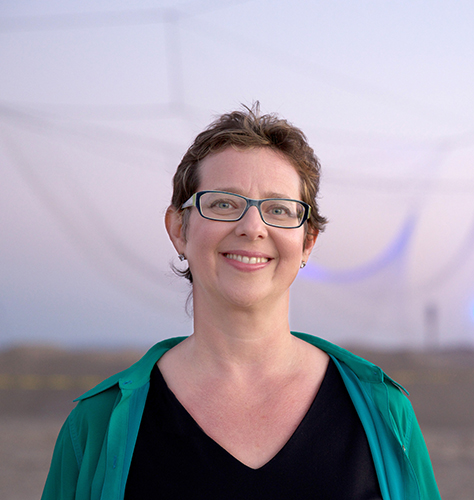L'energia, la forza e i colori di sculture fluttuanti in aria
Photo Andrew K. Sachs
Intervista all'artista americana Janet Echelman in occasione della sua presenza alla Biennale di Helsinki 2021 inaugurata lo scorso 12 giugno.
By Camilla Delpero
Come è nata l'artista "Janet Echelman", come è diventata un'artista?
Non avevo mai veramente fatto arte fino al mio arrivo all'università, quando mi sono imbattuta in un corso di disegno facoltativo. Ho avuto la possibilità di seguire un solo corso d'arte prima della laurea, poi ho capito che essere un artista era l'unica cosa che avrei voluto fare. Quindi ho pensato di fare un tentativo, perché ci sarebbe sempre stato tempo per un compromesso in seguito se avessi fallito. Dopo il college mi sono iscritta a sette scuole d'arte, ma sono stata rifiutata da tutte. Le mie opere a quel tempo erano ancora informi. Ci sono voluti altri dieci anni prima che trovassi la mia voce come scultrice, e altri dieci anni prima di capire come costruire la mia scultura di dimensioni monumentali. Non ho mai studiato scultura, ingegneria o architettura, quindi potrebbe sembrare improbabile che creo quello che sto facendo: forme monumentali e fluttuanti nelle città di tutto il mondo. Non ho lasciato che i rifiuti delle scuole mi fermassero; sono partita da sola per diventare un artista. Prima mi sono trasferita a Bali, in Indonesia, con 300 dollari in tasca, dove ho iniziato a dipingere, e un decennio dopo ho avuto l'opportunità di insegnare pittura in India su una Fulbright, dove una serie di eventi inaspettati mi ha spinto a esplorare la scultura.
Hai dipinto per 10 anni, cosa ti ha fatto cambiare idea?
Ero una giovane pittrice quando ho viaggiato in India con una borsa di studio Fulbright. Promettendo di fare mostre di pittura in tutto il paese per conto dell'Ambasciata degli Stati Uniti, mi ero spedita le mie vernici speciali e le attrezzature per creare i nuovi dipinti. Il giorno dell’inaugurazione era arrivato, ma i miei dipinti non erano pronti. Ero in un terribile cul de sac, senza materiali per realizzare la mia arte. Alloggiavo in un villaggio di pescatori nell'India meridionale e ogni pomeriggio camminavo lungo la lunga spiaggia, osservando i pescatori che impacchettavano cumuli di reti sulla sabbia. Lo vedevo ogni giorno, ma in quell’occasione l'ho percepito in modo diverso: un nuovo approccio alla scultura, un modo per creare forme volumetriche senza materiali solidi pesanti. Le mie prime sculture soddisfacenti sono state realizzate a mano in collaborazione con quei pescatori. Le ho portate in spiaggia e le ho sollevate in aria per fotografarli. Fu allora che scoprii che le loro superfici morbide rivelavano ogni increspatura del vento in modelli in continua evoluzione e ne rimasi ipnotizzata.
Il colore ha un'importanza particolare per la tua arte?
In ciascuno dei miei lavori, creo una sequenza di colori, sia per la fibra che per l'illuminazione, che si sviluppa in relazione al sito in cui li espongo. Lavoro per realizzare opere d'arte che creino un'energia in equilibrio con il suo sito: una combinazione tra l'idea giusta, la forma estetica, la proporzione ottimale e il colore. Anche dopo anni di esperienza, ogni volta devo ancora cercare quell’energia, senza mai sapere come o quando arriverà.
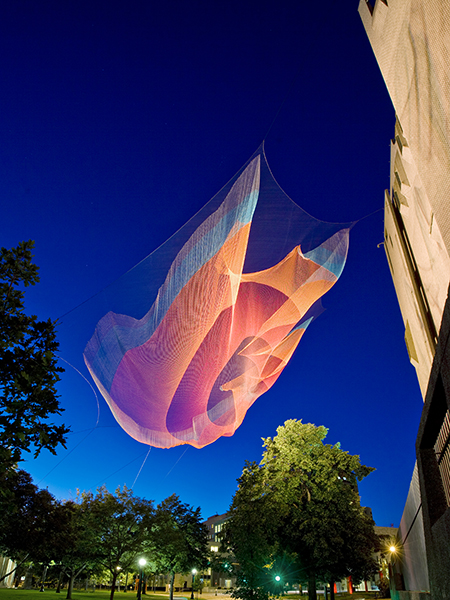
Washington, Photo Peter Vanderwarker.
Quanta preparazione c'è dietro a un progetto come il tuo?
Il nostro processo è un processo collaborativo e iterativo da ogni angolazione e in genere richiede da 1 a 3 anni per crescere dall'idea all'opera d'arte finale. Comincio cercando ispirazione intorno a me: le forme del nostro pianeta in macro e micro scala, i modelli di vita al suo interno, la misurazione del tempo, i modelli meteorologici o i percorsi creati dalla dinamica dei fluidi. Mi rivolgo sempre al luogo espositivo, unico, come forza guida per ogni opera d'arte. Quando effettuo la prima visita al sito, ho un'idea del suo spazio ed esploro la sua storia e la sua consistenza per capire cosa significa per la sua gente. Lavoro con i miei colleghi per un primo brainstorming, disegniamo ed esploriamo tutte le idee, senza censurare nulla nelle prime fasi. Mentre i progetti delle sculture iniziano a svilupparsi, i nostri architetti, designer e modellisti dello studio collaborano con un team esterno di ingegneri aeronautici e strutturali, scienziati informatici, progettisti dell'illuminazione, architetti del paesaggio e urbanisti per trasformare i miei schizzi iniziali in realtà. Fabbrichiamo le nostre opere d'arte attraverso una combinazione di giunzioni manuali e annodatura insieme a telai industriali, e poi installiamo l’opera sul posto.
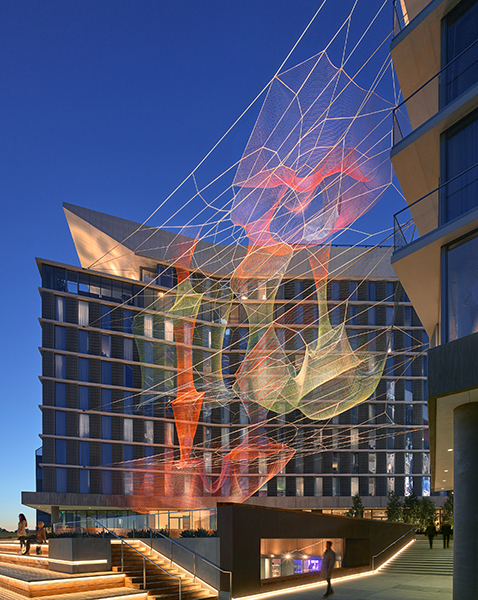
West Hollywood, Dream Catcher, Photo Benny Chan
Dal momento che la tua arte basa anche la sua importanza e i suoi messaggi nella materialità, cosa pensi di un'arte puramente digitale, avrebbe lo stesso impatto?
Posso parlare solo per me stessa. Cerco sempre di intrecciare l'esperienza digitale con l'esperienza fisica. Sappiamo che il nostro ambiente visivo influisce su come ci sentiamo. Influenza il modo in cui sperimentiamo la nostra vita. La mia opera d'arte porta un'esperienza di morbidezza alla scala della città. È un contrappunto agli spigoli vivi degli edifici. Offre la prova che possiamo interrogare lo status quo, l'assunto che le città debbano essere formate da materiali duri e bordi dritti può essere cambiato. Ognuno vive l'opera d'arte pubblica in modo diverso. La mia speranza è che ogni persona diventi consapevole della propria esperienza sensoriale attraverso il coinvolgimento con il mio lavoro. Quel momento contemplativo – quel momento di pausa – può portare ogni persona a creare il proprio significato o racconto. L'arte digitale può anche essere immersiva e trasformativa, ma il mio obiettivo come artista è invitare le persone a vivere un'esperienza sotto la mia scultura e a stabilire una relazione con essa. Se qualcuno nel mezzo della loro vita quotidiana si ferma per notare l'interazione con il vento e la luce del sole che cambia, allora ha raggiunto il mio obiettivo artistico personale.
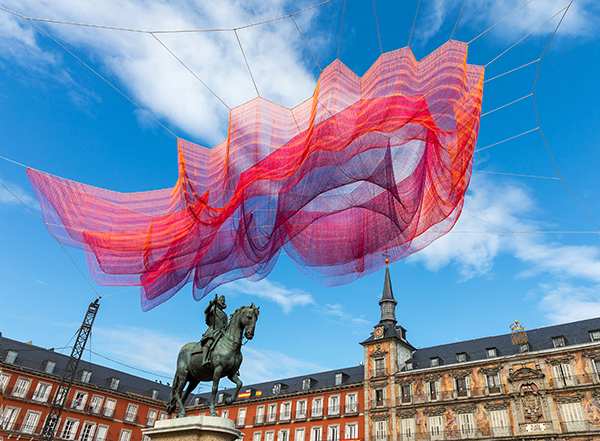
Madrid 1.78, Photo Joao Ferrand
Il tuo maestro o un artista che ti ha ispirato?
Per quanto riguarda chi mi sta ispirando… in questo momento sto guardando i modelli stringati di Antoni Gaudì; le opere di cantiere di Gordon Matta Clark; gli scultori Eva Hesse e Alexander Calder; i pittori Giorgio Morandi, Mark Rothko e Richard Diebenkorn; artisti concettuali come Piero Manzoni; spettacoli creati dalla collaborazione di Robert Rauschenberg e Trisha Brown; e l'architettura storica dal Tempietto del Bramante al Colosseo di Roma.
La rivista si chiama Quid Magazine perché vuole indagare sul quid che muove il mondo. Dove vedi il quid nell'arte in generale o nelle tue opere? Quando il tuo progetto ha il quid e può essere realizzato?
La forza che muove la mia scultura è il vento ed è a disposizione di ognuno di noi in quantità infinita completamente gratuita per tutti.
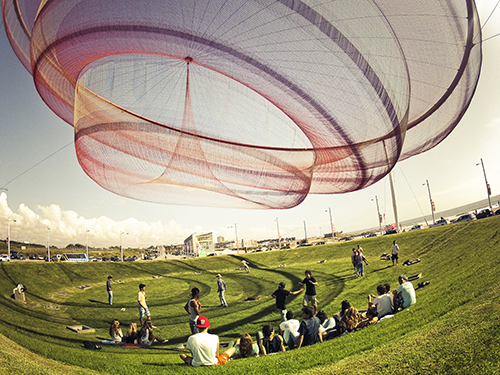
Portogallo, Photo Enrique Diaz
Qual è stata la pulsazione che ti ha permesso di tradurre in arte i fenomeni dei movimenti della terra, dei movimenti tettonici, degli tsunami?
La mia serie di sculture Earthtime cerca di aumentare la nostra consapevolezza sul modo in cui siamo tutti interconnessi tra noi e il nostro mondo fisico. Esplora il contrasto tra le forze che possiamo comprendere e controllare con quelle che non possiamo, e le preoccupazioni della nostra esistenza quotidiana all'interno dei cicli temporali più ampi. È iniziato nel 2010 quando mi è stato chiesto di creare un'opera d'arte per la Biennale delle Americhe che rappresentasse l'interconnessione delle 35 nazioni dell'emisfero occidentale. Stavo seguendo il tragico terremoto che si era appena verificato in Cile e ho visto un'animazione del NOAA che mostrava gli effetti a catena sulla superficie dell'Oceano Pacifico e di tutti i continenti che lo circondano. Poi mi sono imbattuta in un articolo di uno scienziato della NASA che misurava gli effetti del terremoto sull'intero pianeta. Sono stata sorpresa di apprendere che questo singolo evento geologico in una parte del mondo ha avuto effetti a catena in tutto il mondo: ha accelerato la rotazione terrestre e ha accorciato la durata del giorno di 1,26 microsecondi. Questo è diventato il catalizzatore per l'opera d'arte, che ha portato alla "serie Earthtime". Il mio studio modella le forme fisiche per le mie sculture Earthtime utilizzando set di dati scientifici - per la mia scultura "1,26" abbiamo misurato il cambiamento nell'altezza delle onde della superficie dell'oceano come si incresparono attraverso l'intero Oceano Pacifico. La forma della scultura diventa una manifestazione di interconnessione: quando un elemento della scultura si muove, ogni altro elemento viene influenzato.
English Below
How was the artist "Janet Echelman" born, how did she become an artist?
I had never really made art until I arrived at university, when I stumbled into an elective drawing course. I had a chance to take only one art course before graduation, then realized being an artist was the only thing I wanted to do. So I thought I should give it a try, because there would always be time for compromise later if I failed. After college I applied to seven art schools but was rejected by all of them. My works at that time were still unformed. It took ten more years before I found my voice as a sculptor, and another ten years before I figured out how to build my sculpture at the scale of buildings. I never studied sculpture, engineering or architecture, so I may seem like an unlikely person to be doing what I’m doing - creating monumental, billowing forms in cities around the world. I didn’t let the rejections stop me. I went off on my own to become an artist. First I moved to Bali, Indonesia with $300 in my pocket, where I began painting, and a decade later I received the opportunity to teach painting in India on a Fulbright, which is where a series of unexpected events pushed me to explore sculpture.
You've been painting for 10 years, what made you change your mind?
I was a young painter when I traveled on a Fulbright Scholarship to India. Promising to give painting exhibitions around the country on behalf of the US Embassy, I shipped my special paints and equipment to create the new paintings. The deadline for the shows arrived - but my paints did not. I was in a terrible bind, with no materials to make my art. I was staying in a South Indian fishing village, and each afternoon I walked the long beach, watching the fishermen bundling their nets into mounds on the sand. I'd seen it every day, but this time I saw it differently - a new approach to sculpture, a way to make volumetric form without heavy solid materials. My first satisfying sculptures were hand-crafted in collaboration with those fishermen. I brought them to the beach and lifted them into the air to photograph them. It was then that I discovered their soft surfaces revealed every ripple of wind in constantly changing patterns and was mesmerized.

Washington, Photo Peter Vanderwarker
Does color have a particular importance for your art?
In each of my works, I craft a sequence of colors – for both fiber and lighting – that unfold in relationship to the existing site. I work to make artworks that create an energy in balance with its site – a combination of the right idea, the aesthetic form, optimal proportion, and color. Even after years of experience, I still have to search for it every time, never knowing how or when it will come.
How much preparation is there behind a project like yours?
Our process is a collaborative and iterative process from every angle and typically takes between 1-3 years to grow from idea to the final artwork. I begin by looking all around me for inspiration - at the forms of our planet in macro and micro scale, to the patterns of life within it, to the measurement of time, weather patterns, or the paths created by fluid dynamics. I always turn to the unique site as a guiding force for each artwork. When I make the first site visit, I get a feel for its space and explore its history and texture to understand what it means to its people. I work with my colleagues to brainstorm, sketch, and explore all ideas, without censoring our ideas in the early stages. As the sculpture designs begin to unfold, our studio architects, designers and model-makers collaborate with an external team of aeronautical and structural engineers, computer scientists, lighting designers, landscape architects, and city planners to bring my initial sketches into reality. We fabricate our artworks through a combination of hand splicing and knotting together with industrial looms, and then install on location.
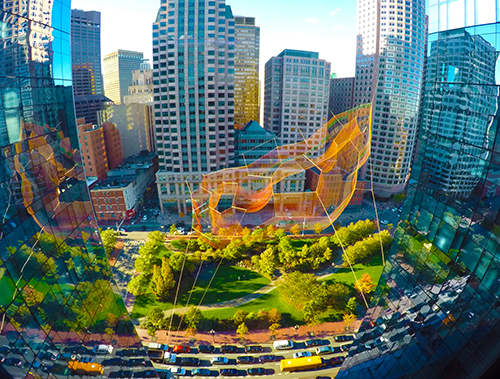
Boston's RoseFitzgerald Kennedy Garden, Photo Bruce Petschek.
Since your art also bases its importance and its messages in the materiality, what do you think about a purely digital art, would it have the same impact?
I can only speak for myself. I am always seeking to interweave digital experience with physical experience. We know our visual environment affects how we feel. It influences how we experience our lives. My artwork brings an experience of softness to the scale of the city. It is a counterpoint to the hard edges of buildings. It offers proof that we can interrogate the status quo - that the assumption that cities must be formed from hard materials and straight edges can be changed. Everyone experiences public artwork differently. My hope is that each person becomes aware of their own sensory experience through engaging with my work. That contemplative moment – that moment of pause – can lead each person to create their own meaning or narrative. Digital art can also be immersive and transformative, but my goal as an artist is to invite people to have an experience underneath my sculpture and form a relationship with it. If someone pauses to notice the interaction with wind and sunlight as it changes in the midst of their daily life, then it has achieved my personal artistic goal.

West Hollywood, Dream Catcher, Photo Benny Chan
Your master, or an artist who inspired you?
In terms of who is inspiring me… at the moment I’m looking at the string models of Antoni Gaudi; the site works of Gordon Matta Clark; sculptors Eva Hesse and Alexander Calder; painters Giorgio Morandi, Mark Rothko, and Richard Diebenkorn; conceptual artists like Piero Manzoni; performances created by the collaboration of Robert Rauschenberg and Trisha Brown; and historical architecture from Bramante’s Tempietto to the Coliseum in Rome.
Our Magazine is named Quid Magazine beacause we want to investigate the quid that moves the world. Where do you see the quid in art in general or in your works? When does your project have the quid and can it be realized?
The force which moves my sculpture is the wind and it is available to all of us with infinite quantity completely free to everyone.

Madrid 1.78, Photo Joao Ferrand
What was the pulse that allowed you to translate the phenomena of earth movements, tectonic movements, tsunamis into art?
My Earthtime sculpture series seeks to heighten our awareness about the way we are all interconnected with one another and our physical world. It explores the contrast between the forces we can understand and control with those we cannot, and the concerns of our daily existence within the larger cycles of time. It began in 2010 when I was asked to create an artwork for the Biennial of the Americas which represented the interconnectedness of the 35 nations of the Western Hemisphere. I had been following the tragic earthquake that had just occurred in Chile, and I viewed an animation from NOAA showing the ripple effects on the surface of the Pacific Ocean and all the continents surrounding it. Then I came across an article by a NASA scientist that measured the effects of the earthquake on the entire planet. I was surprised to learn that this single geologic occurrence in one part of the world had ripple effects all over the world - it sped up the earth’s rotation and shortened the length of the day by 1.26 microseconds. This became the catalyst for the artwork, which led to the “Earthtime series.” My studio models the physical forms for my Earthtime sculptures using scientific data sets – for my “1.26” sculpture we measured the change in wave heights of the ocean’s surface as they rippled across the entire Pacific Ocean. The sculpture’s form becomes a manifestation of interconnectedness – when any one element in the sculpture moves, every other element is affected.

Portogallo, Photo Enrique Diaz.

